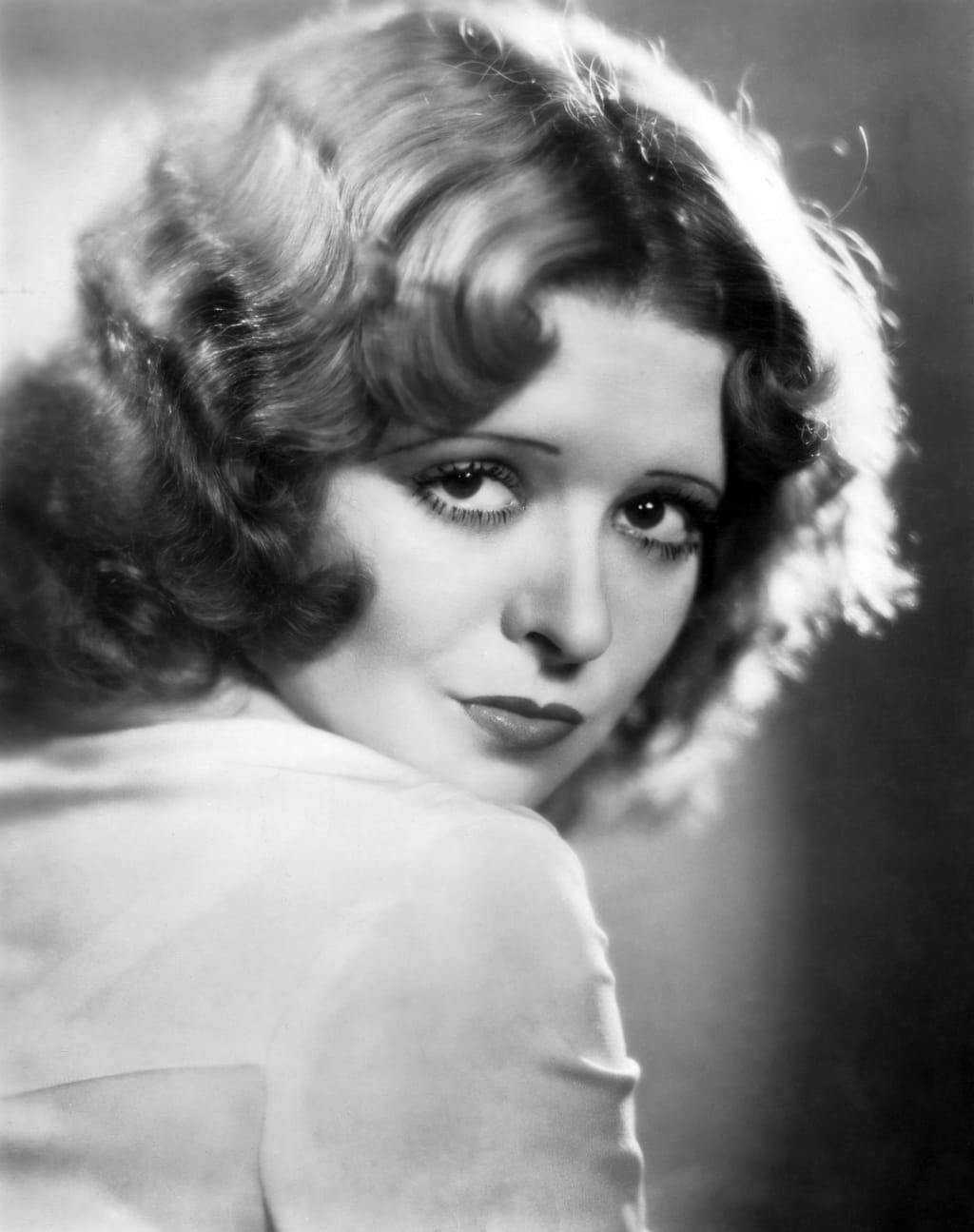
The Original "It" Girl
She appeared in 46 silent films and 11 talkies, including “Mantrap” (1926), “It” (1927), and “Wings” (1927). At the peak of her stardom, she received more than 45,000 fan letters in a single month (January 1929). Thinking that she would die in childbirth, her mother didn’t get a certificate recording the birth. She herself, although a beautiful actress, was plagued with mental problems.
She was Clara Bow.
Clara didn’t really stand much of a chance at the beginning of her life but, despite all the odds, she still became a famous film actress. Before she was anywhere near being conceived, her mother, Sarah Francis Bow (nee Gordon, 1880 - 1923), fell from a second-storey window at 16 years of age, and suffered a severe head injury. As a result, Sarah was diagnosed with “psychosis due to epilepsy”.
Clara had two older sisters but they both died in infancy. So when Sarah became pregnant with Clara (against the doctor’s advice), it was not expected that either mother or child would live, which is why Sarah never got the birth certificate. Clara later wrote: “I don’t suppose two people ever looked death in the face more clearly than my mother and I the morning I was born. We were both given up, but somehow we struggled back to life”.
On July 29th, 1905, in a “bleak, sparsely furnished room above a dilapidated Baptist Church”, Clara was born during a heatwave when temperatures peaked at 100 F / 38 C. The building was in Prospect Heights, Brooklyn, at 697 Bergen Street.
Both of her parents were descended from English and Scots-Irish immigrants who had come to America the generation before. Her father was Robert Walter Bow (1874-1959), who “had a quick, keen mind — all the natural qualifications to make something of himself, but didn’t — everything seemed to go wrong for him, poor darling", (Clara wrote of her father). Between 1905 and 1923, the family lived at 14 different addresses, seldom outside of Prospect Heights, with her father usually out of work and absent. Clara wrote about this time: “I do not think my mother ever loved my father. He knew it. And it made him very unhappy, for he worshipped her ".
From a young age Clara learnt how to deal with her mother’s seizures and psychotic and hostile ‘episodes’. Clara said about her mother, that she could be “mean to me — and she often was. She didn’t mean to be and it was because she couldn’t help it. As a kid I took care of my mother, she didn’t take care of me”. Clara felt deprived of her childhood. During one of these ‘episodes’, Clara woke up in the middle of the night, with her mother holding a butcher knife against her throat. Clara managed to escape and her father had her mother committed to a sanatorium. Her mother had no recollection of the ‘episode’. However, whilst her mother was institutionalized, Clara was raped by her father. She was 16 years of age. Sarah died of an epileptic fit on January 5th, 1923.
“Clara developed into a lonely, hypersensitive child, acutely self-conscious of a slight speech impediment” (Stenn). Whilst alive, her mother would ‘entertain’ visit firemen and ‘uncles’ and Clara would hide in a cupboard, terrified.
Clara’s only escape from such an oppressive childhood was the then new medium “the moving pictures”. Here, she could forget the constant fights between her parents and the fact that her mother’s ‘episodes’ were getting worse. Her favourite actresses were Mary Pickford, Mae Nurray and Theda Bara, and Clara would ‘imitate’ their acting styles in front of a mirror.
Every American girl dreamed of winning a fan magazine contest, (in the early 1920’s), because it was sometimes a move towards becoming a movie actress. Clara, of course, was no different and was desperate to escape from her unhappy home life. Having faith in herself, Clara saved what little money she could to ‘search out’ the studios in New York. She entered one such contest which was sponsored by Motion Picture, Motion Picture Classic and Shadowland Magazines.
In 1922, the January edition of Motion Picture Magazine announced Clara as the winner of the 1921 Fame and Fortune contest. The magazine published about their winner, Clara:
“She is very young, only 16. But she is full of confidence, determination and ambition. She is endowed with a mentality far beyond her years. She is a genuine spark of the divine fire. The five different screen tests she had, showed this very plainly, her emotional range of expression provoking a fine enthusiasm from every contest judge who saw the tests. She screens perfectly. Her personal appearance is almost enough to carry her to success without the aid of the brains she indubitably possesses”.
Clara won an evening gown and a silver trophy, and a promised part in a motion picture. The feature was “Beyond the Rainbow” and Clara had a small part as a flirtatious sub-deb, but her scenes were cut from the finished film.
Her next and more successful part was in the movie “Down to the Sea in Ships”. Clara was offered $35 a week for 13 weeks to play ‘Dot Morgan’. The film premiered at the Olympia Theatre in New Bedford, On September 25th, 1922. Clara was billed 10th in the film but shone through: “With her beauty, her brains, her personality and her genuine acting ability it should not be many moons before she enjoys stardom to the fullest sense of the word. You must see ‘Down to the Sea in Ships’”.
Making her way to Hollywood, Clara signed with Preferred Pictures whose chief was B.P.Schulberg. Over the next few years, Clara starred in several silent films: Black Oxen (1923), Grit (1924), Wine (1924), The Plastic Age (1925) and Dancing Mothers (1926). It was a grueling work schedule but Clara was happy for the work, using every emotion in her acting and often she would ‘transcend’ the bad material that was put in front of her.
A novella by Elinor Glyn was adapted into the movie “It” and it was Clara’s performance in this which finally put her in the movie history books. Her magnetism and electric, sexy performances spoke to the flapper persona of the time. Being red-headed, Clara also became a styled icon with women copying her style across the country.
“She seemed to really enjoy what she was doing. I think it was the desire of her life to be a film actress in Hollywood — later being the “It girl” she was kind of a conniving shop-girl who wanted to catch her man. But that wasn’t her role in “Helen’s Babies”. Clara plays a simple homespun girl. She seemed to have a bubbly enthusiastic, youthful nature — and she appeared to me to be natural and true to herself”. (Diana “Baby Peggy” Cary — “Clara Bow: Discovering the It Girl”)
After starring in dozens of films, the rigorous shooting demands and the pressures of the industry exploitation affected Clara’s mental health. Her last film was “Hoopla” with Fox Studios and Clara retired in 1933 at the age of 28.
"She had been a child of poverty and neglect and had suddenly come into money, fame, and if not business or political power, at least an understanding of her own sexual power. She became known for her very colourful off-screen life, and was eventually brought low by scandal — her many love affairs, madcap adventures, and careless, sometimes drunken exploits were well known”. (Basinger)
Clara had a breakdown in 1931 and entered a sanitarium. After several weeks there, she went home to Nevada to recover and left the film industry for good in 1933, after making her last film.
In 1931, whilst recovering from the mental breakdown, Clara met her future husband and fellow actor Rex Bell. They married that same year and moved into his ranch in Searchlight, Nevada, South of Las Vegas. The couple had two sons: Rex, “Tony”, born in 1934, and George, born in 1938.
Clara and Rex briefly had a restaurant called the “It” Cafe in the late 193’s. Rex then entered into politics and served as Nevada’s lieutenant governor. In 1947, Clara temporarily returned to acting and became the voice of the character Mrs.Hush on the radio game show ‘Truth or Consequences’.
However, Clara continued to suffer with her mental health, attempting suicide int he mid-1940’s, and undergoing a score of examinations. Clara was eventually diagnosed with schizophrenia.
Rex died in 1962. Clara herself died in 1965 in Los Angeles of a heart attack. The famous “It” girl was 60 years of age when she died.
Even though Clara’s life started exceptionally hard and she didn’t really stand much of a chance, the young actress was determined to carve out for herself a career and became one of the most famous silent movie actresses of her time. Clara Bow was (and still is) a real Inspiration for us today.
About the Creator
Ruth Elizabeth Stiff
I love all things Earthy and Self-Help
History is one of my favourite subjects and I love to write short fiction
Research is so interesting for me too






Comments
There are no comments for this story
Be the first to respond and start the conversation.